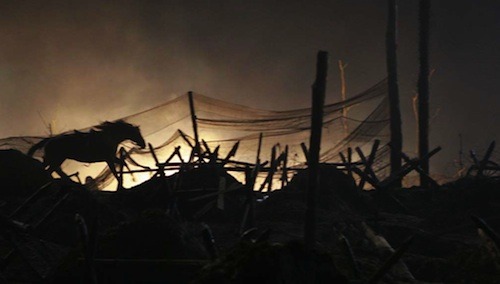Stephen Spielberg is no stranger to war. At least no stranger to portraying its horror, destruction and utter senselessness and still somehow managing to make it beautiful – Schindler’s List, Saving Private Ryan. For beauty isn’t always sunshine and roses. Within the vileness of war lies hope and humanity: wars are fought by soldiers, by human beings – and where there are people, there will be hope. Spielberg knows this and is one of the rare filmmakers to create films of faith, rather than films that focus on the life’s filth. His are films where people take precedence, not politics.
The First World War was one of man’s greatest atrocities, but one leaves War Horse feeling strangely uplifted. But only after Spielberg takes us on an emotional rollercoaster ride of triumph and despair, from Dartmoor to the trenches, from War to Peace. Michael Morpurgo’s novel of the same name failed to win the Whitbread literary award back in 1982. It laid in wait for over two decades before galloping into the public’s attention in a mightily innovative production at the National Theatre in 2007 that is showing no signs of slowing down.

A remarkable, remarkable horse.
There has been some skepticism about whether such a tailor-made for stage production could ever successfully succeed on screen. No doubt, the puppet mastery of the theatre is not something that could be transferred easily to film, but Spielberg’s film version is not seeking to do this. Like the book and stage versions were entities unto themselves, so too is the film. One can always define something by something it isn’t – and then nothing would be good.
The cast includes newcomer Jeremy Irvine, whose career has gone from zero to ninety in a heartbeat: his last role was in a play in which he had no lines. Irvine plays Albert, who loses his beloved horse Joey to the cavalry at the start of the war. Joey spends the war being shunted from one owner to another, from Captain Nicholls (played by the ever-awesome Tom Hiddleston) to young German soldiers, from a young French girl to the Germans again, and finally back to Joey in the trenches. One of the film’s most moving and funny scenes is the interaction between the Geordie soldier and a German one as they cut Joey out of the barbed wire in No Man’s Land – one would never tell it was plastic barbed wire they had used.
Another feat of genius was The Charge, early on in the film and war. The hooves of over a hundred English horses hammering down and rumbling like thunder before descending onto a German campsite – best enjoyed through large speakers! Hiddleston and Benedict Cumberbatch – who plays Nicholls’ superior Major Jamie Stewart, trained for six weeks to appear seamless in the saddle. And seamless they were.
There are too many great things to say about War Horse to comfortably fit into a review. Solid gold casting – Emily Watson, Niels Arestrup, David Thewlis to name but a few – and plenty of dashing young fellows in uniform: expect more to come from Toby Kebbell (Geordie soldier), David Kross (Gunther, Joey’s first German ‘owner’) and Robert Emms (David Lyons, son to David Thewlis’ Mr Lyons).
If I were to really split hairs, I would say that some of the cast struggled with the gorgeous Devon accent. A fact that would otherwise pass unnoticed to anyone who doesn’t know Devon.
The English countryside is captured at its best – green pastures, rolling hills, granite-stoned walls and cottages. The film concludes with spectacular sunset to rival anything from the tropics that one assumes is pure CGI. Wrong! The director decided to rewrite the film’s ending to include the serendipitous capture of the sunset. This spontaneity and flexibility Spielberg has marks him out as a true artist and also earns him the awe of the actors he works with.
Special praise must be reserved for the films equine excellence. As Jeremy Irvine joked, the horses almost upstage their human co-stars. And that special praise must also go to the horses’ trainers who made it all happen. The horses’ skills were so honed that there one felt these were people: non-human people. It is a credit to both human and non-human actors that such wonderful chemistry and relationships were evident. What the puppeteers of the National’s production did to bring the animals to life on stage, was rivaled with what was created with real animals in this film. Neither one can be said to be superior. They are both stupendous.
Be ready for tears – and enjoy them. This is Old-School Hollywood. A Classic of a movie that will be watched, along with all the other Greats of your childhood for generations to come.
